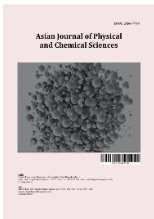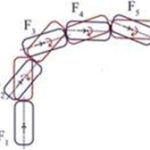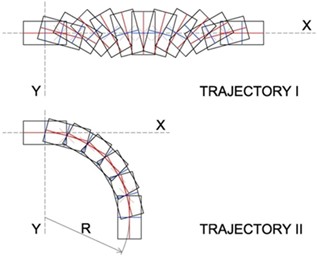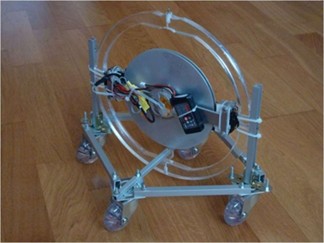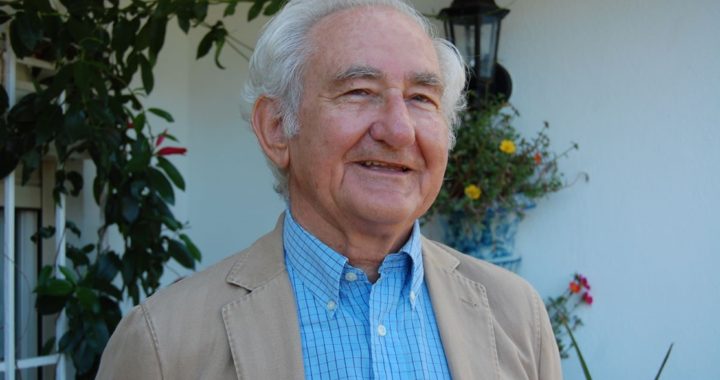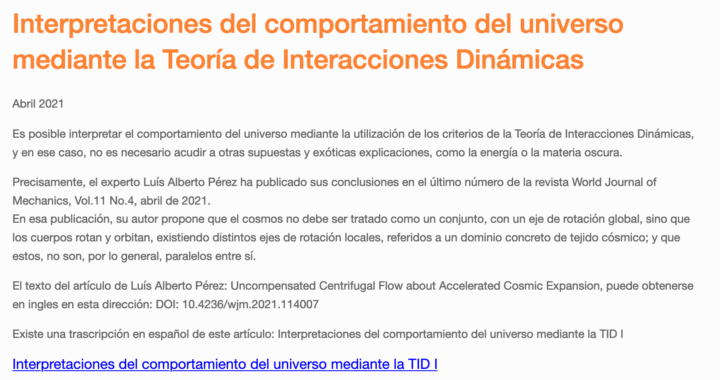Advanced Dynamics CB, Madrid, Spain.
Author’s contribution
The sole author designed, analysed, interpreted and prepared the manuscript..
Article Information
DOI: https://doi.org/10.9734/ajopacs/2024/v12i2224
Open Peer Review History:
This journal follows the Advanced Open Peer Review policy. Identity of the Reviewers, Editor(s) and additional Reviewers,
peer review comments, different versions of the manuscript, comments of the editors, etc are available here:
https://www.sdiarticle5.com/review-history/117062
ABSTRACT
Over the last forty years we have conducted a methodical investigation process with a view to better understanding the behavior of rigid solid bodies that are simultaneously subject to accelerations owing to non-coaxial rotations. We have taken part in a long and complex investigation and examination procedure by way of applying the scientific method to try and explain
our observations that are not in keeping with the accepted paradigm or pattern.
Keywords: Theory of dynamic interactions; methodical investigation; rigid solid bodies
1. INTRODUCTION
“We have developed a dynamic knowledge structure for non-inertial systems, called the Theory of Dynamic Interactions (TID) as part of non-inertial dynamic knowledge” [1].
This theory incorporates a causal demonstration of phenomena accelerated by rotation, which would complement Classical Mechanics. This theory is based on the hypotheses of inertial reactions and on the principles of conservation of measurable, such as momentum, total mass, and total energy, and the concepts of rotational inertia; dynamic interaction; velocity coupling or constant rotation. We believe that the TID mathematical model that we propose is of great conceptual importance.
Short Communication
Barceló; Asian J. Phys. Chem. Sci., vol. 12, no. 2, pp. 54-62, 2024; Article no.AJOPACS.117062
55
Fig. 1. Trajectory of a body endowed with translational velocity and rotation around its main axis when subjected to a new turn not coinciding with the existing rotation.1
2. TEORÍA DE INTERACCIONES DINAMICAS
Recientemente la revista Journal of Applied Mathematics and Physics, me ha publicado el articulo: Analysis of the Orbitation and Rotation of Celestial Bodies, (2023). https://www.scirp.org/journal/paperinformation.aspx?paperid=128107 en el que describo, con casos y supuestos, la TEORIA DE INTERACCIONES DINÁMICAS (TID), y en este caso, su aplicación para entender el movimiento simultaneo de rotación y orbitación de los cuerpos celestes.
Todo nació hace muchos años al querer indagar sobre las investigaciones de mi profesor Miguel Catalán. En el referido texto, daba el ejemplo de un cuerpo en el espacio, con trayectoria rectilínea, dotado de velocidad de traslación y rotación alrededor de su eje principal, el cual es sometido a un par de fuerzas externas no coincidentes con su propia rotación; por ejemplo, un par de flotabilidad/peso, contenido en el plano del dibujo, como ocurría en nuestro experimento de un prototipo de submarino, a escala.2
Figura 1. Trayectoria de un cuerpo dotado de velocidad de traslación y rotación alrededor de su eje principal, cuando se le somete a un nuevo giro no coincidente con la rotación existente. 1
En nuestras pruebas experimentales, habíamos llegado a la conclusión de que el campo de velocidades que se genera por ese par de flotabilidad/peso, obligaba al móvil a girar sobre un eje vertical perpendicular al par externo actuante (Figura 1). En rojo está representado el móvil desplazado (pero con la orientación anterior) y en azul está la nueva orientación del móvil debido al acoplamiento dinámico que se produce. Y llegábamos al resultado de que se produce el referido acoplamiento. o unión de ambos campos de velocidades (traslacional y anisotrópico debido al par de fuerzas que actúan) y, en consecuencia, al cambio de trayectoria del móvil, que iniciaba una órbita, como la de la Tierra alrededor del Sol, si las condiciones externas se mantenían constante.
Con esa prueba experimental habíamos llegado a la conclusión de que el modelo aceptado que intentaba justificar el comportamiento de la Tierra, alrededor del Sol es erróneo, y que no es la Ley de la Gravitación Universal la que genera esa trayectoria orbital, simultanea con su rotación.
1 Barceló, G: New paradigm in physics. Ed. Amazon, 2017/ 2018.
Figura 2: La trayectoria I es la establecida por la mecánica clásica, y la trayectoria II es la que resulta de la Teoría de Interacciones Dinámicas que proponemos, y que ha sido comprobada en numerosos ensayos y pruebas.2
Llegamos a la conclusión de que las leyes de Newton pueden ser validas en supuestos sin aceleraciones, pero no cuando nos encontramos con móviles con rotaciones.
Repetimos las pruebas experimentales con otros móviles, y llegamos a la conclusión de que el modelo propuesto por Newton para justificar la órbita de la Tierra, y que había sido respetado por Einstein era, en nuestra opinión claramente erróneo, y que tenía que ser sustituido por el modelo concebido por la TID [3- 28].
Además, el enunciado de Newton, necesariamente tenía que generar una órbita ondulante, tanto para la Tierra, como para la Luna: su trayectoria estaría influenciada por las fuerzas de la gravedad en cada punto de su órbita, por lo que, en el caso de la Luna, su órbita fluctuaría en función de la posición relativa del Sol y de la Tierra respecto de la Luna. No sería la misma orbita resultante si estos estuviesen en conjunción o en oposición.
Por otro lado, la TEORIA DE INTERACCIONES DINAMICAS, además de justificar la órbita de la Tierra, de la Luna y de los cuerpos celestes, permitía la comprensión de otros fenómenos dinámicos de la naturaleza, como el vuelo del bumerang, el baile de la peonza, el giróscopo, el péndulo giroscópico, el epostracismo, los fenómenos de vórtice atmosférico, el confinamiento dinámico, las anomalías dinámicas de las sondas Pioneer, la palanca dinámica, el gobierno de móviles sin timón, las pelotas y balones con efecto, el Roll Coupling de los aviones, las bombas rasantes que rebotaban, de la segunda guerra mundial, el disco de Euler o el bote de refresco que se eleva sin fuerza ascendente que lo empuje, y de otros muchos ejemplos dinámicos.
2 Barceló, G: New paradigm in physics. Ed. Amazon, 2017/ 2018.
Figura 3: Modelo de prototipo de submarino con depósitos de agua a popa y proa, con el que se demostró su cambio de trayectoria, sin la necesidad de un timón, conforme a lo previsto en la TID.3
Todos estos ejemplos, y muchos más, se describen en el segundo tomo del libro: NUEVO PARADIGMA EN FÍSICA y se pueden también conocer mediante los portales: https://advanceddynamics.net/ y http://www.dinamicafundacion.com/, y en diferentes videos. Las pruebas experimentales realizadas son fácilmente reproducibles según el método científico. Advanced Dynamics ha convocado tres concursos sucesivos para la posible refutación o antítesis de la teoría propuesta, sin obtener respuesta. Los videos de presentación de la TID se pueden encontrar también en: http://www.youtube.com/watch?v=k177OuTj3Gg&feature=related o en https://youtu.be/keFgx5hW7ig.
Figura 4. La Precesión en dinámica rotacional se genera cuando se aplica una fuerza a un cuerpo en rotación, obligándole a realizar un nuevo giro, sobre un nuevo eje. La respuesta del móvil no es ese nuevo giro, si no que reacciona como si la fuerza se hubiese aplicado en otro punto, que le obliga a realizar un movimiento de orbitación, al acoplarse esa nueva rotación inducida, con la velocidad de traslación existente, generándose por este fenómeno, la trayectoria en órbita de los cuerpos celestes.4
3 Barceló, G: New paradigm in physics. Ed. Amazon, 2017/ 2018.
4 Barceló, G.: Theory of Dynamic Interactions. Global Summit on Physics Congress, Madrid, 27 September 2018, 1-31.
Este extraño comportamiento de los cuerpos con rotación sobre un eje se debe al fenómeno de precesión, que se produce cuando al cuerpo en movimiento, y con rotación, se le obliga a realizar un nuevo giro sobre un nuevo eje.
Como resumen del artículo referido, al final proponíamos estas conclusiones: El modelo mecánico establecido por la Ley Universal de la Gravedad de Newton debe considerarse un modelo aproximado, aunque ha perdurado durante siglos en nuestro paradigma científico.
Nuestras hipótesis TID se basan en el acoplamiento de campos de velocidad de traslación en cada punto del objeto en movimiento, incluso si estos campos son causados por movimientos de traslación, o generados por acciones externas, que podrían crear nuevas rotaciones no coincidentes con otras posibles preexistentes en el móvil.
Figura 5. Prototipo terrestre II con ruedas giratorias, que permitía su control de dirección, con resultados similares a los del submarino.5
Creemos que nuestras propuestas y los resultados, sugieren nuevos horizontes para la dinámica rotacional, y nuevas claves para comprender la armonía del universo. El universo está constituido no sólo por fuerzas sino también por sus efectos, pues actúan constantemente sobre cuerpos celestes en rotación con velocidad de traslación constante, dando como resultado una órbita cerrada. Por tanto, es un sistema en movimiento, aunque también se encuentre en un constante estado de equilibrio dinámico.
¿No es precisamente este equilibrio que observamos del cosmos, el comportamiento de la mecánica rotacional?
Los movimientos orbitales que observamos en los cuerpos celestes son el resultado de un acoplamiento dinámico no previsto en la Mecánica Clásica, como se expresa en la TID, permitiendo un equilibrio dinámico secular.
En consecuencia, creemos que el modelo matemático TID que proponemos es de gran importancia conceptual. Además, pensamos que no sólo es necesario comprender la dinámica de los cuerpos en rotación sino también la del cosmos,
5 Barceló, G: New paradigm in physics. Ed. Amazon, 2017/ 2018.
con cuerpos que orbitan y tienen movimientos constantemente recurrentes, que hacen posible sistemas que han estado en equilibrio dinámico durante siglos, y no están necesariamente en un proceso de expansión ilimitada. Incluso creemos que esta nueva teoría dinámica mejora nuestra comprensión de nuestro universo y de la materia de la que está hecho.
3, MODELO MATEMATCO
Hemos llevado a cabo el análisis de estos casos en el campo de la Teoría de Campos. Después de observar la naturaleza y teniendo en cuenta las deducciones obtenidas a partir de los principios dinámicos utilizados, hemos llegado a la conclusión de que la aplicación sucesiva de momentos no coaxiales, sobre un sólido rígido en movimiento, puede generar los siguientes resultados:
- Distribuciones de velocidad no homogéneas y de aceleraciones que se generan dentro de la masa de los móviles, que conforman campos de esas
- Acoplamiento discriminante de los campos dinámicos: los campos resultantes de los pares o momentos no necesariamente se acoplan entre sí.
- El campo existente debido a la rotación intrínseca, no se acopla con el campo del movimiento de traslación del centro de masas del cuerpo.
- Los campos generados por el par actuante se acoplan con el campo del movimiento de traslación existente.
- El móvil se ve obligado a iniciar una nueva trayectoria, describiendo una órbita cerrada, si el par actuante es constante.
Estas hipótesis son criterios diferenciales de la Teoría de las Interacciones Dinámicas, que pueden ser, y han sido, confirmados con pruebas experimentales, y con un modelo matemático que permite la simulación del comportamiento real de los cuerpos sometidos a estas excitaciones.
Se ha obtenido una clara correlación entre el momento inicial, las especulaciones e hipótesis, las leyes dinámicas rotacionales, los ensayos experimentales realizados, y el modelo matemático resultante correspondiente a las ecuaciones de movimiento de nuestra propuesta
Como resultado podemos obtener la variación de la dirección de la velocidad de traslación del móvil, mediante la aplicación de la fórmula de nuestro modelo:
E incorporando la matriz del operador obtenemos la ecuación resultante:
4. RESULTADOS DE LAS PRUEBAS
A pesar de las dificultades para realizar un experimento en tierra, dado las inevitables aceleraciones negativas debido a la fricción con la superficie del suelo, con el aire y también debido a las presentes en los rodamientos y motores, no obstante, fue posible realizar las pruebas en el agua.
Si no existieran tales fricciones, las mediciones que podrían tomarse con respecto a ambas velocidades, como los radios instantáneos de curvatura, verificarían hipotéticamente el marco teórico que el profesor Barceló propone en su Teoría de Interacciones Dinámicas a través de varias publicaciones y artículos. El campo inercial se acopla y se suma vectorialmente a cualquier campo de velocidad del centro de masa del sistema…
…La principal diferencia entre estos experimentos, el realizado sobre ruedas giratorias y la prueba del submarino realizada por Gabriel Barceló Rico-Avello es que, en este caso, el momento lineal rectilíneo y el momento angular principal son ambos inerciales (aunque negativamente acelerados debido a múltiples fricciones).
Como ambos momentos de rotación y traslación son inerciales, se activa el torque secundario, sirviendo para demostrar que el centro de masa se desvía de la dirección marcada por su vector de velocidad rectilínea.
Las nuevas hipótesis dinámicas, propuestas por el profesor Gabriel Barceló, fueron demostradas empíricamente, confirmando debidamente que los campos de velocidad generados por el torque de interacción dinámica se acoplan dinámicamente con el campo inercial del sistema rectilíneo.6
A partir del estudio de este y otros fenómenos derivados de observaciones de cuerpos dotados de momento angular, simultáneamente sujetos a la acción de algún torque no colineal con ellos, concluimos la necesidad de perseverar aún más en estos estudios. El hecho de haber ignorado estas hipótesis, que son un área importante de la dinámica no inercial, puede haber sido debido a la falta de una herramienta matemática adecuada. Por lo tanto, alentamos la búsqueda de un nuevo sistema matemático, un nuevo álgebra para comprender la dinámica rotacional, y también destacamos la necesidad de investigar y estudiar más a fondo los campos de velocidad y los campos inerciales de la materia bariónica.7 Este artículo y el video adjunto confirman la hipótesis mencionada anteriormente
6 Pérez. L. A.: New Evidence on Rotational Dynamics, World Journal of Mechanics, Vol 3, No. 3, 2013, pages 174-177, doi: 10.4236/wjm.2013.33016.
http://www.scirp.org/journal/wjmhttp://dx.doi.org/10.4236/wjm. 2013.33016
7 Pérez. L. A. Reflecting new evidence on rotational dynamics, script of http://vimeo.com/68763196 th
expuesta por el profesor Barceló en su artículo: “Análisis de Campos Dinámicos en Sistemas No Inerciales”, publicado en el Vol. 2, No. 3, junio de 2012, en el “World Journal of Mechanics”, incluso bajo condiciones verdaderamente inerciales.
En consecuencia, entiendo que la teoría mencionada es un nuevo paradigma del comportamiento dinámico. Creo que estas conclusiones modifican los fundamentos de la dinámica racional, incorporando nuevos criterios de gran impacto e importancia en la disciplina.8
5. Conclusiones
Los test iniciales y experimentales más importantes realizados durante los últimos treinta años en este proyecto de investigación han sido descritos. Además de los referidos en este texto, se realizaron numerosas otras pruebas y experimentos con otros prototipos especialmente diseñados, así como con una amplia variedad de instrumentos y modelos.
Las pruebas se realizaron con objetos móviles en el aire, en el agua o en tierra, por lo tanto, los resultados homogéneos obtenidos sirven simplemente para confirmar aún más nuestras hipótesis y sostener nuestra teoría. Después de haber repetido tales pruebas diversas, no había posibilidad de atribuir los resultados obtenidos a fenómenos inesperados, a efectos aerodinámicos, o a aquellos de cualquier otra naturaleza.
Las pruebas confirman, sin ningún margen de error, la Teoría de Interacciones Dinámicas propuesta. Como dijo Galileo Galilei: La filosofía está escrita en ese gran libro que siempre está abierto ante nuestros ojos, me refiero al universo, pero no podemos entenderlo si no aprendemos primero el lenguaje y captamos los símbolos en los que está escrito.9
RENUNCIA (INTELIGENCIA ARTIFICIAL)
El autor declara que NO hay IA generativa tecnologías como los Grandes Modelos de Lenguaje (ChatGPT, COPILOT, etc.) y de texto a imagen se han utilizado generadores durante la escritura o edición de manuscritos.
INTERESES CONTRAPUESTOS
El autor declara que no tienen conocimiento de Intereses financieros concurrentes o intereses no financieros, o relaciones personales que podrían haber influido en el trabajo reportado en este documento.
8 Pérez. L. A.: New Evidence on Rotational Dynamics, World Journal of Mechanics, Vol 3, No. 3, 2013, pages 174-177, doi: 10.4236/wjm.2013.33016. http://www.scirp.org/journal/wjm http://dx.doi.org/10.4236/wjm.2013.33016
9 Galilei, Galileo: Il Saggiatore, 1623. Publisher: Sarpe, 1984 – Volume 35 Great Thinkers.
REFERENCIAS:
1 Barceló, Gabriel: Analysis of the orbitation and rotation of celestial bodies. Journal of Applied Mathematics and Physics. 2023;11:2765 2774. DOI:10.4236/jamp.2023.119179. Available: https://www.scirp.org/journal/pap erinformation.aspx?paperid=128107
- 3. 4. 5. 6. 7. 8. 9. Barceló, Gabriel: Rotational mechanics. Generalization of Movement in space. Available:
www.ijisset.org Volume: 5 Issue: 12, 2019 Available: https://ijisset.org/storage /Volume5/Issue12/ IJISSET-051119.pdf
- Barceló, Gabriel: Miguel Catalán’s CXXV Anniversary December 10, 2019 Advances in Historical Studies Vol.8 No.5 DOI: 10.4236/ahs.2019.85017
- Barceló, Gabriel: Advanced Dynamics: Technological Applications Engineering and Technology 2019;4(08). Available: https://everant.org/index.php/etj/article/vie w/342/305
- Barceló, Gabriel: A New Celestial Mechanics Dynamics of Accelerated Systems. Journal of Applied Mathematics and Physics August 16, 2019. DOI: 10.4236/jamp.2019.78119
- Barceló, Gabriel: Theory of Dynamic Interactions. Global Summit on Physics, 27/9/2018.
- Barceló, Gabriel: Global summit on physics & world congress on quantum and nuclear 19/9/2018. Enlace
- Dinámica Fundación: The Universe does not necessarily 04/04/2018.
- Barceló, Gabriel: New Paradigm in Physics: Assumptions and applications of the theory of dynamic interactions, Volume II: Theory of Dynamics Interactions, Amazon, 2018. (Español e ingles), Available: http://advanceddynamics.net/
- Gabriel Barceló. Theory Of Dynamic Interactions: Synthesis. Transactions on Machine Learning and Artificial Intelligence, 5. No 5; p. 10, oct. 2017. ISSN 2169-4726. Available:
http://dx.doi.org/10.14738/tmlai.5 5.3344 11.
- Barceló, Gabriel: New Paradigm in Physics, Volume I: Theory of Dynamics Interactions. Amazon, 2017. (Español e ingles).
- Barceló, Gabriel: Dynamic Interaction: A New Concept of Confinement, Global Journal of Science Frontier Research: A Physics and Space Science, Vol 16 no.3, Junio 2016, Video.
- Barceló, Gabriel: Theory of Dynamic Interactions: The Flight of the Boomerang II, Journal of Applied Mathematics and Physics, Vol.3 no.5, Mayo 2015. DOI:10.4236/jamp.2015.35067, Available: https://youtube.com/watch?v=mGfrG W5fhOg&feature=youtu.be.
- Barceló, Dynamic Interactions in the Atmosphere, Atmospheric and Climate Sciences. 2014;4(5). DOI: 10.4236/ACS.2014.45073 15. Barceló, Gabriel. On Motion, Its Relativity And The Equivalence Principle. Journal of Modern Physics. 2014;5(17)14. DOI: 10.4236/jmp.2014.517180
- Barceló, Gabriel. Dynamic interaction confinement. World Journal of Nuclear Science and Technology. 2014;4(4)29. DOI: 10.4236/wjnst.2014.44031.
- Barceló, Gabriel. Theory of dynamic interaction: Laws of motion. World Journal of Mechanics. 2013;3(9):10. DOI: 10.4236/wjm.2013.39036. Available:https://scirp.org/pdf/WJM_2 013121013261555.pdf.
- Barceló, Proporsal of new criteria for celestial mechanics. International Journal of Astronomy and Astrophysics. 2013;3(4). DOI: 10.4236/ijaa.2013.34044 Available:https://www.scirp.org/pdf/IJAA_2 013111114164800.pdf.
- Barceló, Gabriel. Technological applications of the new Theory of Dynamic Interations. Global Journal of Researches in Engineering-A: Mechanics Mechanical Engineering and (GJRE-A). 2013;13(5).
- Barceló, Gabriel. Analysis of dynamics fields in noninertial systems. World Journal of Mechanics. 2012;3(3). DOI: 10.4236/wjm.2012.23021

